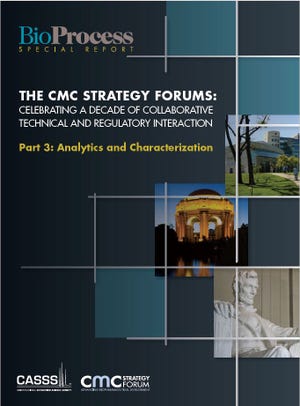September 2015 CMC Special Report
KEMWELL BIOPHARMA (WWW.KEMWELLBIOPHARMA.COM)
Both small and large biopharmaceutical companies are increasingly pursuing the outsourcing of manufacturing and testing throughout the product lifecycle. The growing use of contract manufacturing organizations (CMOs) and contract testing organizations (CTOs) has led to increasing complexity within the biopharmaceutical industry as more third-party sites are leveraged to support global markets.
To address those issues, a CASSS Chemistry, Manufacturing, and Controls (CMC) Strategy Forum was held in Washington, DC, 27–28 July 2014. The title was “Effective
Management of Contract Organizations: Sponsors, Contract Organizations, Health Authorities and Patients — Keeping the Product Pipeline Moving, Compliant, and
Available.” The CMC Strategy Forum is a series of meetings that focus on emerging and relevant CMC issues throughout a product’s life cycle. The forums foster collaborative sharing of information among industry participants and regulatory agencies. Their go...
www.istockphoto.com
The CMC Strategy Forums provide a venue for biopharmaceutical product discussion. They focus on relevant chemistry, manufacturing, and controls (CMC) issues throughout the life cycle of a therapeutic and thereby foster collaborative technical and regulatory interaction. Forum chairs share information with regulatory agencies to help them merge good scientific and regulatory practices. Outcomes of the forum meetings are published in
BioProcess International
and on the CASSS website (www.casss.org). This process is meant to help ensure that biopharmaceutical products manufactured with advancing technologies in a regulated environment will continue to be safe and efficacious.
This special report series highlights five general subject areas that have been covered in the first 10 years of the CMC Strategy Forum series: quality by design (QbD) and risk management; manufacturing strategies; analysis and characterization; assays, biosimilars, and comparability; and process- and product-relat...
Cosponsored by CASSS (an international separation science society) and the US Food and Drug Administration (FDA), the January 2010 CMC Strategy Forum explored antibody–drug conjugates (ADCs), which are monoclonal antibodies (MAbs) coupled to cytotoxic agents. The ADC platform of products is being used more and more for clinical evaluation in oncology. More than a dozen companies are developing several types, including products conjugated with calicheamicin, auristatins, and maytansinoids. Such products use the specificity of a MAb to deliver a cytotoxic drug to tumor cells. Depending on the chemistry of linkage, sites of attachment, and synthetic route for the small-molecule component, various chemistry, manufacturing, and control (CMC) issues arise during development and regulatory review of ADCs. Determining the appropriate assays for characterization and quality assurance (QA) is important, as is identifying potential critical quality attributes (CQAs) for the conjugate, antibody, cytotoxic agent, and ...
A CMC Strategy Forum held in Washington, DC, on Sunday 28 January 2007 focused on two topics related to protein structure and function (1). First, analytical techniques used in the glycan analysis characterization included recent advances and correlations among the various tools. And second, current understanding of glycosylation’s functional relevance to therapeutic proteins was discussed in the context of its effects on biological activity, pharmacokinetics, and Fc effector functions (for monoclonal antibodies, MAbs). Progress has been made in the field of glycobiology since this forum took place, and those updates can be found in articles referenced herein.
Two Sessions
The morning session’s goal was to develop a general understanding of the variety of analytical tools available for carbohydrate analysis: their limitations, strengths, and suitability for use in routine lot-release monitoring. The plenary session was chaired by Rohin Mahtre (Biogen Idec) and Blair Fraser (FDA CDER), with three speakers:
On 6 January 2003, 129 attendees participated in the second Well-Characterized Biotechnology Product (WCBP) Chemistry and Manufacturing Controls (CMC) strategy forum, titled “Analysis and Structure Characterization of Monoclonal Antibodies (MAbs),” held in San Francisco to discuss lot release and characterization test issues specific to MAbs (
1
).
The objective of the meeting was twofold: to identify a “core” set of assays most useful for lot-release testing of MAbs and to define a mechanism for selecting appropriate potency tests. Two separate workshops were held as a part of the strategy forum discussing these topics in detail. The purpose of this article is to describe the discussion that occurred and to define the “core” set of assays that are most frequently used for MAb characterization and lot-release testing.
Two Sessions
The morning session featured talks by three experts using a case study format to provide an industry perspective and approach to the test methods used for characterization and ...
The January 2005 CMC Strategy Forum was devoted to a discussion of live virus vaccines and viral vectors used for gene therapy. The purpose of the meeting was to determine whether consensus positions could be reached among the delegates regarding lot release, stability, characterization, and comparability testing. Part 1 of this two-part report on that meeting describes factors influencing the choices of lot-release assays for vaccines and gene-therapy products (
1
). Part 2 presents potency testing, characterization, and comparability studies, including case studies and discussion (
2
).
Two Sessions
The morning session featured plenary presentations by Keith Peden (CBER, Office of Vaccines Research and Review) and Denise Gavin (CBER, Office of Cellular, Tissues, and Gene Therapies). Peden presented an overview of factors that influence the choice of lot release assays for vaccines. Gavin described how gene therapy products are delivered through a vector with the intent of directly expressing a gene in ...
Subscribe to receive our monthly print or digital publication
Join our 70,000+ readers. And yes, it's completely free.








